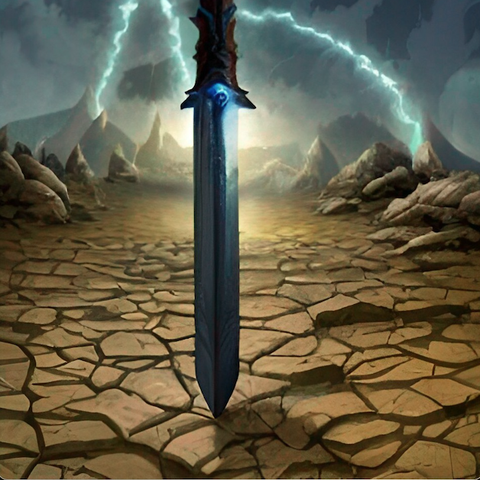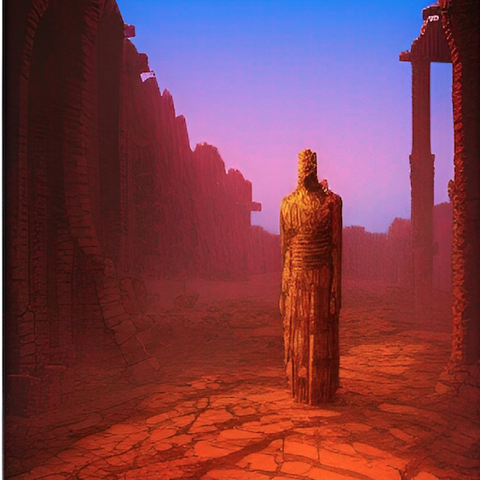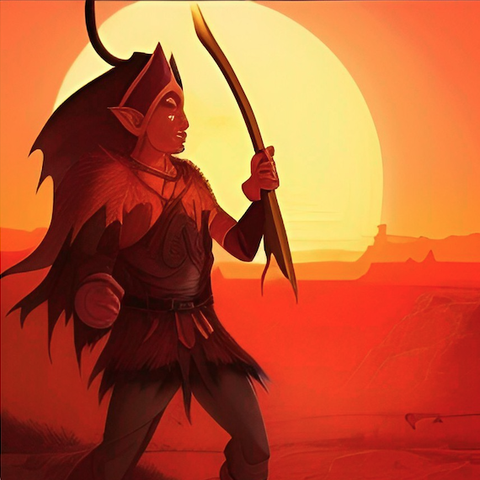Kanka is built by just the two of us. Support our quest and enjoy an ad-free experience for less than the cost of a fancy coffee. Become a member.
Athas is a hot, arid planet covered with endless seas of dunes, lifeless salt flats, stony wastes, rocky bad lands, thorny scrublands, and worse. From the first moments of dawn, the crimson sun beats down from an olive tinged sky. The wind is like the blast of a furnace, offering no relief from the oppressive heat. Dust and sand borne on the breeze coat everything with yellow-orange silt. In this forbidding world, cities and villages exist only in a few oases or verdant plains. Some places don’t see rain for years at a time, and even in fertile regions, rain is little more than a humid mist that falls during a few weeks each year before giving way to long months of heat and drought. The world beyond these islands of civilization is a wasteland roamed by nomads, raiders, and hungry monsters. Athas was not always a desert, and the parched landscape is dotted with the crumbling ruins of a planet that once was rich with rivers and seas. Ancient bridges over dry watercourses and empty stone quays that face seas of sand tell the tale of a world that is no more.

Life on Athas is brutal and short. Bloodthirsty raiders, greedy slavers, and hordes of inhuman savages over run the deserts and wastelands. The cities are little better; each chokes in the grip of an ageless tyrant. The institution of slavery is widespread on Athas, and many unfortunates spend their lives in chains, toiling for brutal taskmasters.
Every year hundreds of slaves, perhaps thousands, are sent to their deaths in bloody arena spectacles. Charity, compassion, kindness – these qualities exist, but they are rare and precious. Only a fool hopes for such riches.

Most arms and armor are made of bone, stone, wood,
and other such materials. Mail or plate armor exists only
in the treasuries of the sorcerer-kings. Steel blades are
almost priceless, weapons that many heroes never see
during their lifetimes.
 The reckless use of arcane magic during ancient wars
reduced Athas to a wasteland. To cast an arcane spell,
one must gather power from the living world nearby.
Plants wither to black ash, crippling pain wracks animals
and people, and the soil is sterilized; nothing can grow
in that spot again. It is possible to cast spells with care,
preserving the world and avoiding any more damage to it,
but defiling offers more power than preserving. As a result,
sorcerers, wizards, and other wielders of arcane magic are
reviled and persecuted across Athas regardless of whether
they preserve or defile. Only the most powerful spellcasters
can wield arcane might without fear of reprisal.
The reckless use of arcane magic during ancient wars
reduced Athas to a wasteland. To cast an arcane spell,
one must gather power from the living world nearby.
Plants wither to black ash, crippling pain wracks animals
and people, and the soil is sterilized; nothing can grow
in that spot again. It is possible to cast spells with care,
preserving the world and avoiding any more damage to it,
but defiling offers more power than preserving. As a result,
sorcerers, wizards, and other wielders of arcane magic are
reviled and persecuted across Athas regardless of whether
they preserve or defile. Only the most powerful spellcasters
can wield arcane might without fear of reprisal.
Terrible defilers of immense power rule all but one of the city-states. These mighty spelicasters have held their thrones for centuries; no one alive remembers a time before the sorcerer-kings. Some claim to be gods, and some claim to serve gods. Some are brutal oppressors, where others are more subtle in their tyranny. The sorcerer-kings govern through priesthoods or bureaucracies of greedy, ambitious templars, spellcasters who can call upon the kings’ powers. Only in the city-state of Tyr does a glimmer of freedom beckon, and powerful forces already conspire to extinguish it.

Long ago, when the planet was green, the brutal might of the primordials overcame the gods. Today, Athas is a world without deities. There are no clerics, no paladins, and no prophets or religious orders. Old shrines and crumbling temples lie amid the ancient ruins, testimony to a time when the gods spoke to the people of Athas. Nothing is heard now but the sighing of the desert wind. In the absence of divine influence, other powers have come to prominence in the world. Psionic power is well known and widely practiced on Athas; even unintelligent desert monsters can have deadly psionic abilities. Shamans and druids call upon the primal powers of the world, which are often sculpted by the influence of elemental power.
The desert planet has its own deadly ecology. Athas
has no cattle, swine, or horses; instead, people tend flocks
of erdlus, ride on kanks or crodlus, and draw wagons with
mixes and mekillots. Wild creatures such as lions, bears,
and wolves are nonexistent. In their place are terrors such
as the id fiend, the baazrag, and the tembo. Perhaps
the harsh environment of Athas breeds creatures tough
and vicious enough to survive it, or maybe the touch
of ancient sorcery poisoned the wellsprings of life and
inflicted monster after monster on the dying world. Either
way, the deserts are peril ous, and only a fool or a lunatic
travels them alone.
Typical fantasy stereotypes don’t apply to Athasian
heroes. In many settings, elves are wise, benevolent forest
dwellers who guard their homelands from intrusions of
evil. On Athas, elves are a nomadic race of herders,
raiders, peddlers, and thieves. Halflings aren’t amiable
riverfolk; they’re xenophobic headhunters and cannibals
who hunt and kill trespassers in their mountain forests.
Goliaths or half-giants, as they are commonly known are
brutal mercenaries who serve as elite guards and enforcers
for the sorcerer kings and their templars in many citystates.
What’s the difference between defilers and preservers?
Basically, it revolves around the way these types of wizards
gather the energy necessary to cast spells. Defilers, as
their name implies, corrupt the source they draw energy
from, while preservers keep the source safe and relatively
unchanged. This difference in methods is reflected in
each wizard type’s philosophy and manner.
Defilers absorb every bit of life energy they can hold,
with the result that the land they tap into is leeched and
left barren of nutrients, incapable of supporting plant life.
Plants in the defiled area die and turn to ash when the
life spark is removed. Unlike with natural death, however,
the decaying process occurs in an instant, and nothing
remains within the dead ash to continue the life cycle
– plants killed by defiling magic return nothing to the
soil and don’t revert to life-giving fertilizer when they die.
Defilers, therefore, are vampiric, stealing life energy not
only because they need it to utilize magic, but for the
rush of power it gives them. Basically, defilers take the
quick and easy road to power, caring little that they leave
devastation in their wake.
Preservers have learned a more subtle approach to
magic, one which allows them to return to the land what
they take from it. Preservers focus their wills upon tapping
the energy of the land and its plant life without destroying
the actual life force which imbues it. Their magic is slower
and more careful than that of the defilers. They gently
tap the source for the minimum amount of energy needed
to power their spells, filter it into the form they wish to
use, then release the energy back to its original source.
In this sense, preservers are like birds, culling the nectar
from plants, yet not destroying them in the process. The
bird receives the nectar it needs, but leaves the plant
healthy, allowing it to produce more nectar in the future.
Preservers accept a slower method of learning magic and
of gathering energy as the price they must pay to maintain
the fragile ecology of Athas.
/src/notes/R6dHVEkTbCuIhIdEomE1V3QaJtg3ocZ7QYA3eB7h.png)
/src/notes/R6dHVEkTbCuIhIdEomE1V3QaJtg3ocZ7QYA3eB7h.png)
/src/notes/crdIFqZLnKHKHxC58yjZoBvh6JeHdXujxRYNOnjC.png)
/src/notes/crdIFqZLnKHKHxC58yjZoBvh6JeHdXujxRYNOnjC.png)




/src/notes/GaMkJR3vhpjBjpXFYc1r5V79aZtBusq5eeDqpTPO.png)
/src/notes/GaMkJR3vhpjBjpXFYc1r5V79aZtBusq5eeDqpTPO.png)






/src/notes/D9vGjINBbv92Ka33kItZcmh7x0WLUkQA7RIchkBL.png)
/src/notes/D9vGjINBbv92Ka33kItZcmh7x0WLUkQA7RIchkBL.png)